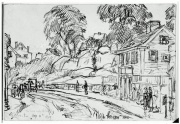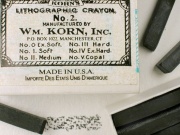Difference between revisions of "Lithograph crayon"
Jump to navigation
Jump to search
m (Text replace - "\[http:\/\/cameo\.mfa\.org\/materials\/fullrecord\.asp\?name=([^\s]+)\s(.*)\]" to "$2") |
|||
| (One intermediate revision by the same user not shown) | |||
| Line 1: | Line 1: | ||
| − | [[File:58.606-C36428.jpg|thumb|]] | + | [[File:58.606-C36428.jpg|thumb|LIthographic crayon and pencil; MFA# 58.606]] |
== Description == | == Description == | ||
| − | + | [[File:lithog.crayon_gen.jpg|thumb|Lithograph crayon]] | |
| − | A type of grease pencil used to draw an image on a flat surface for reproduction by the lithographic technique. The crayon lines attract and hold an oily ink used in the printing process. Litho crayons contain [[tallow|tallow]] or [[stearic| | + | A type of grease pencil used to draw an image on a flat surface for reproduction by the lithographic technique. The crayon lines attract and hold an oily ink used in the printing process. Litho crayons contain [[tallow|tallow]] or [[stearic acid|stearic acid]], [[wax|wax]] ([[carnauba wax|carnauba]], [[beeswax|beeswax]]), resin ([[copal|copal]], [[shellac|shellac]]), and [[lampblack|lampblack]]. They also contain an alkali, such as [[lye|lye]] or [[potassium carbonate|potassium carbonate]], to saponify the fatty acids. The ingredients are mixed, heated then cast into sticks for crayons or thin rods for pencils. They are available in varying hardness: five for the pencil type and seven for the crayon type. |
See also [[tusche|tusche]]. | See also [[tusche|tusche]]. | ||
| − | |||
| − | |||
== Synonyms and Related Terms == | == Synonyms and Related Terms == | ||
litho crayon; lithographic crayon | litho crayon; lithographic crayon | ||
| − | == | + | == Risks == |
| − | |||
| − | |||
| − | + | * Halos may form when used on absorbent material. | |
| + | * Bloom may form on surface. | ||
| − | + | == Physical and Chemical Properties == | |
| − | + | Soluble in aromatic hydrocarbons, turpentine. Slightly soluble in ethanol, water. | |
| − | + | ==Resources and Citations== | |
| − | + | * M. Holben Ellis, M. Brigitte Yeh, "Categories of Wax-based Drawing Media" WAAC Newsletter, Vol 19(3), 1997. | |
| − | * | + | * Ralph Mayer, ''A Dictionary of Art Terms and Techniques'', Harper and Row Publishers, New York, 1969 (also 1945 printing) |
| − | * | + | * Michael McCann, ''Artist Beware'', Watson-Guptill Publications, New York City, 1979 |
| − | * | + | * Book and Paper Group, ''Paper Conservation Catalog'', AIC, 1984, 1989 |
* ''A Glossary of Paper Conservation Terms'', Margaret Ellis (ed.), Conservation Center of the Institute of Fine Arts, New York City, 1998 | * ''A Glossary of Paper Conservation Terms'', Margaret Ellis (ed.), Conservation Center of the Institute of Fine Arts, New York City, 1998 | ||
Latest revision as of 13:38, 15 October 2022
Description
A type of grease pencil used to draw an image on a flat surface for reproduction by the lithographic technique. The crayon lines attract and hold an oily ink used in the printing process. Litho crayons contain Tallow or Stearic acid, Wax (carnauba, Beeswax), resin (Copal, Shellac), and Lampblack. They also contain an alkali, such as Lye or Potassium carbonate, to saponify the fatty acids. The ingredients are mixed, heated then cast into sticks for crayons or thin rods for pencils. They are available in varying hardness: five for the pencil type and seven for the crayon type.
See also Tusche.
Synonyms and Related Terms
litho crayon; lithographic crayon
Risks
- Halos may form when used on absorbent material.
- Bloom may form on surface.
Physical and Chemical Properties
Soluble in aromatic hydrocarbons, turpentine. Slightly soluble in ethanol, water.
Resources and Citations
- M. Holben Ellis, M. Brigitte Yeh, "Categories of Wax-based Drawing Media" WAAC Newsletter, Vol 19(3), 1997.
- Ralph Mayer, A Dictionary of Art Terms and Techniques, Harper and Row Publishers, New York, 1969 (also 1945 printing)
- Michael McCann, Artist Beware, Watson-Guptill Publications, New York City, 1979
- Book and Paper Group, Paper Conservation Catalog, AIC, 1984, 1989
- A Glossary of Paper Conservation Terms, Margaret Ellis (ed.), Conservation Center of the Institute of Fine Arts, New York City, 1998

